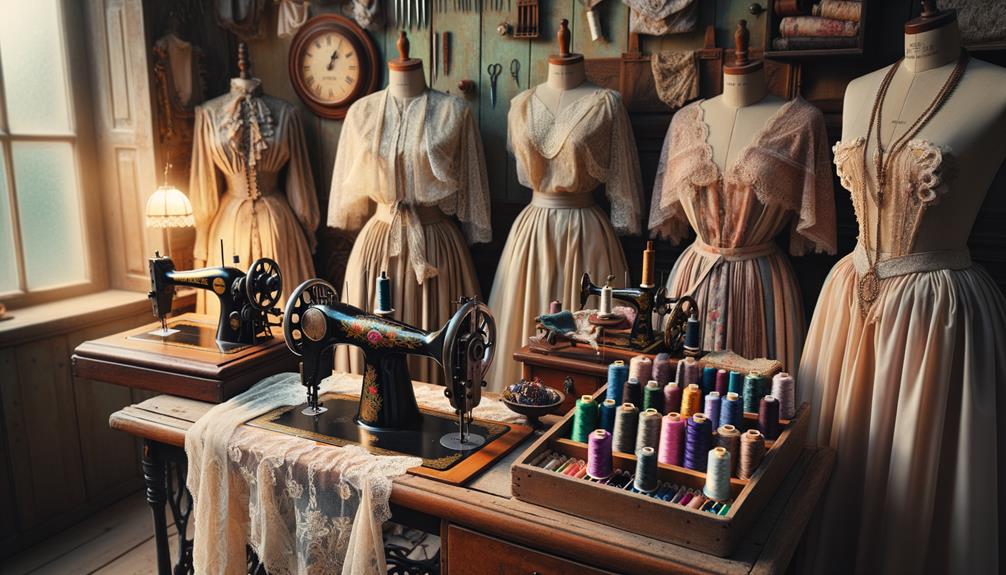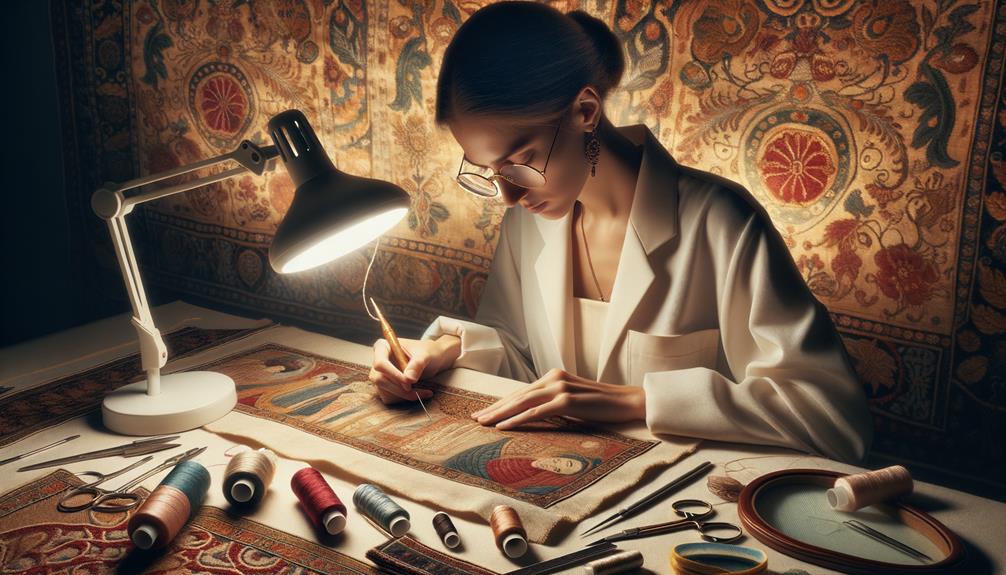I approach preserving historical fashion pieces with deep respect and care. I begin by donning cotton gloves and removing jewelry to protect delicate fabrics. Acid-free tissue paper becomes essential, carefully cushioning each garment to prevent damage over time. I maintain a stable environment, with consistent temperature and humidity levels, and shield these fragile pieces from harsh light. Every step, from gentle cleaning with pH-neutral products to displaying away from direct sunlight, honors their legacy. The intricacies of preservation continue to unfold, revealing hidden stories and techniques to cherish and protect these fragments of history.
Proper Handling Techniques
When handling historical garments, I take great care to wear cotton gloves and remove any jewelry to prevent damage to the delicate fabrics. Before touching the garments, I ensure my hands are clean and dry to prevent oils or dirt from transferring onto the fragile textiles. The sensation of wearing cotton gloves reminds me of the garment's fragility, prompting a sense of reverence and caution.
To further protect the garments, I use acid-free tissue paper, gently folding it around the fabric to cushion and support its structure. This simple step is crucial in safeguarding the garment's integrity over time. Each fold is a deliberate act of preservation, a small but significant measure to guard against the passage of time.
Handling these delicate pieces requires a thoughtful approach, blending respect for the past with a focus on future preservation. By meticulously following proper handling techniques, I'm not just preserving fabric; I'm safeguarding the stories and history woven into each thread. This is essential for preserving historical garments, honoring the original creators and the people who wore them. It's a labor of love, a careful and deliberate process aimed at honoring history.
Optimal Storage Conditions
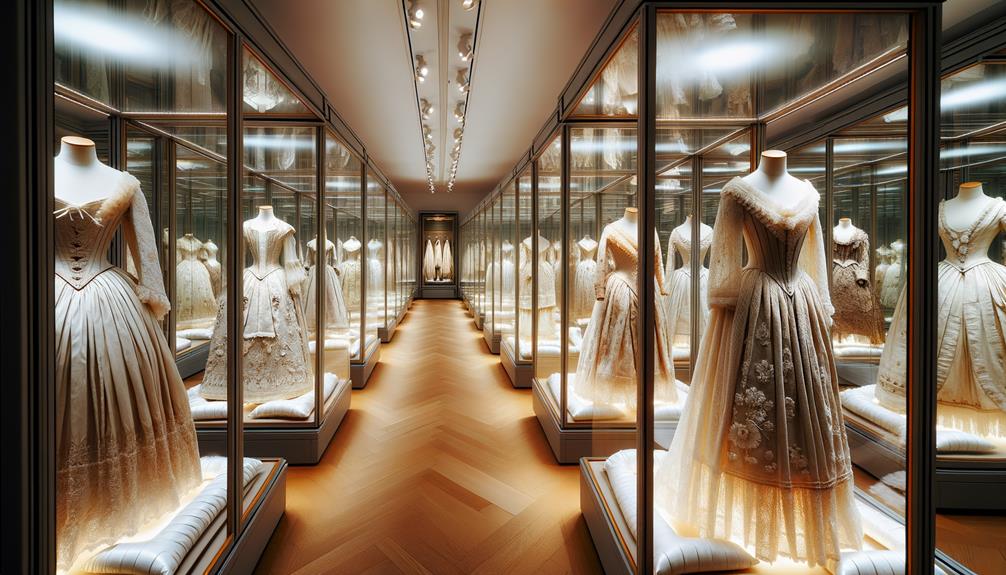
Preserving historical fashion is about more than just handling pieces with care; it's also about creating the right environment for them. To prevent deterioration, consistent temperature and humidity levels are crucial, along with protection from harsh light. As I set up the storage, I'm thinking about how these factors will safeguard the delicate fabric for years to come.
Temperature and Humidity Control
Preserving historical textiles requires meticulous control over temperature and humidity to prevent irreversible damage. Storing these precious artifacts in a cool, dry location makes all the difference. The ideal storage temperature should range from 65°F to 70°F (18°C to 21°C). Any deviation can invite moisture damage, a silent threat to delicate fabrics.
Managing humidity levels is equally crucial. A relative humidity (RH) of 30% to 50% is the optimal range. Higher humidity invites mold, while lower levels can cause fiber brittleness. Basements, attics, or garages are not suitable for storing these treasures due to high humidity. Instead, I use acid-free boxes and papers to shield them from environmental fluctuations. Silica gel packets or other desiccants are essential in maintaining stability.
Vigilance is key. Regularly monitoring temperature and humidity levels helps me stay ahead of potential issues. If changes occur, immediate adjustments are necessary to maintain the delicate balance. Every degree and percentage point matters significantly in this precise preservation process.
Light Exposure Minimization
Preserving historical textiles requires careful consideration of light exposure to prevent fading and deterioration. Even minimal light exposure can cause damage over time. When storing textiles, I opt for areas with limited natural light, such as closets or under beds, to reduce the risk of damage from direct and indirect light sources.
Direct sunlight and UV-emitting bulbs can break down fibers and cause colors to fade. To mitigate this, I use UV-protected glass or acrylic for display cases and shadowboxes. Rotating textiles every 6-12 months also helps prevent cumulative light damage and maintains their archival quality.
Storing textiles in dark or dimly lit areas is another effective strategy. It's essential to be mindful of even low levels of light, as they can be detrimental over time. By taking these precautions, I can ensure that these precious historical fashion pieces remain preserved for generations to come.
Choosing Preservation Materials
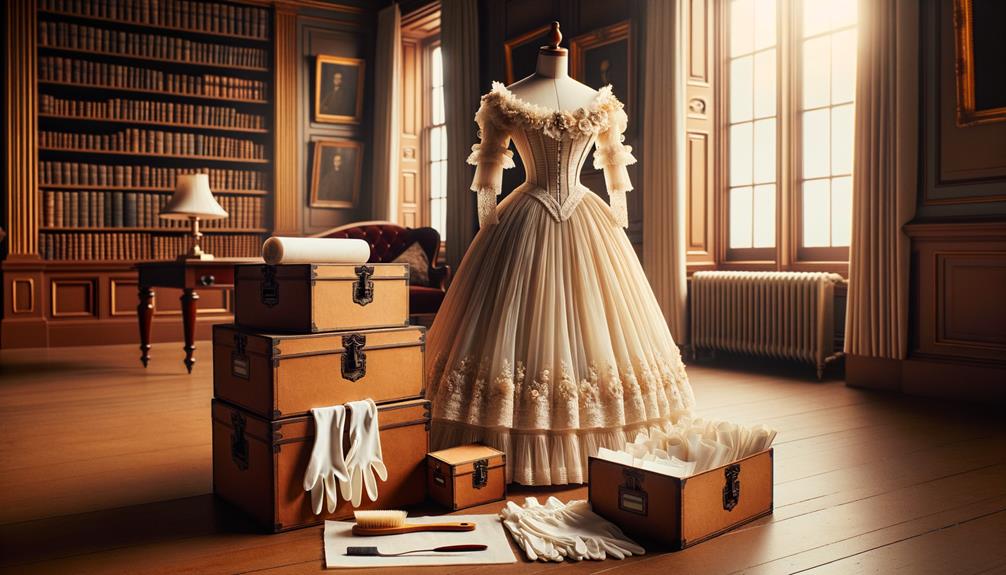
When I think about preserving historical fashion, the choice of materials feels like a delicate balancing act between protection and reverence. Using acid-free tissue paper and maintaining climate control are essential steps in ensuring each garment's longevity. Every layer, every box, and every glove must be carefully selected to honor the integrity of these precious pieces.
Acid-Free Storage Solutions
Choosing the right storage materials is crucial when it comes to preserving antique textiles. The materials we select can greatly impact the longevity and condition of these delicate pieces.
Opting for acid-free storage materials is vital. Boxes, paper, and tissue designed for archival storage are pH-neutral, ensuring they won't degrade or harm the textiles over time. I always look for products certified by reputable organizations to guarantee they meet the highest standards of archival quality.
When handling these textiles, I use lignin-free tissue paper to avoid any acidity that could damage the fabric. It's essential to handle these materials with care; they're specifically designed for textile storage, providing a gentle touch for fragile fibers.
Selecting storage boxes made from corrugated cardboard or polypropylene is another important step. These materials are breathable, durable, and pest-resistant, providing a safe haven for my precious textiles. Handling with clean, dry hands or gloves ensures that no oils from my skin transfer, preserving the integrity of these elegant artifacts.
Climate Control Essentials
Maintaining a stable climate is crucial for preserving historical garments. The storage area must be meticulously managed to remain clean and pest-free. I avoid using chemicals like mothballs, which can harm both fabrics and human health.
A cool, dry environment is essential for preserving delicate textiles. Wild temperature and humidity fluctuations, common in attics or basements, can be detrimental. Instead, I seek a location with consistent conditions. A stable temperature and humidity level protect the integrity of the garments.
Different materials require specific storage conditions. For instance, unbuffered materials are ideal for animal protein-based items like wool and silk, while buffered materials suit plant-based fibers like cotton. I use acid-free archival tissue paper to cradle each piece, preventing acid migration and potential damage. Each box is meticulously labeled, ensuring easy identification without unnecessary unpacking and repacking.
In this controlled environment, every garment can breathe and remain in its best possible condition, preserving its historical value and beauty for generations to come. This careful balance of material and environment is the cornerstone of effective textile preservation.
Protective Coverings Options
Selecting the right protective coverings for historical garments requires a deep understanding of the unique needs of each fabric. For instance, garments made from animal proteins like wool and silk need unbuffered materials to prevent adverse chemical reactions. On the other hand, plant-based fibers such as cotton thrive in buffered environments.
To preserve these delicate textiles, acid-free archival tissue paper is used to wrap them gently, shielding them from acidic damage. When handling a dress, I carefully roll and position the tissue paper within the chest, bodice, and sleeves to maintain its shape and prevent creasing during storage.
Choosing the right storage box is equally crucial. I measure each piece accurately and select boxes specifically designed for textile storage to avoid unnecessary folding. Large, flat textiles like quilts are rolled around acid-free cardboard tubes to preserve their integrity.
Every decision in this preservation process, from selecting acid-free materials to finding the perfect storage solution, demonstrates a commitment to respecting and honoring the stories these garments tell. The ultimate goal is to protect and preserve these historical garments for generations to come.
Cleaning and Maintenance Tips
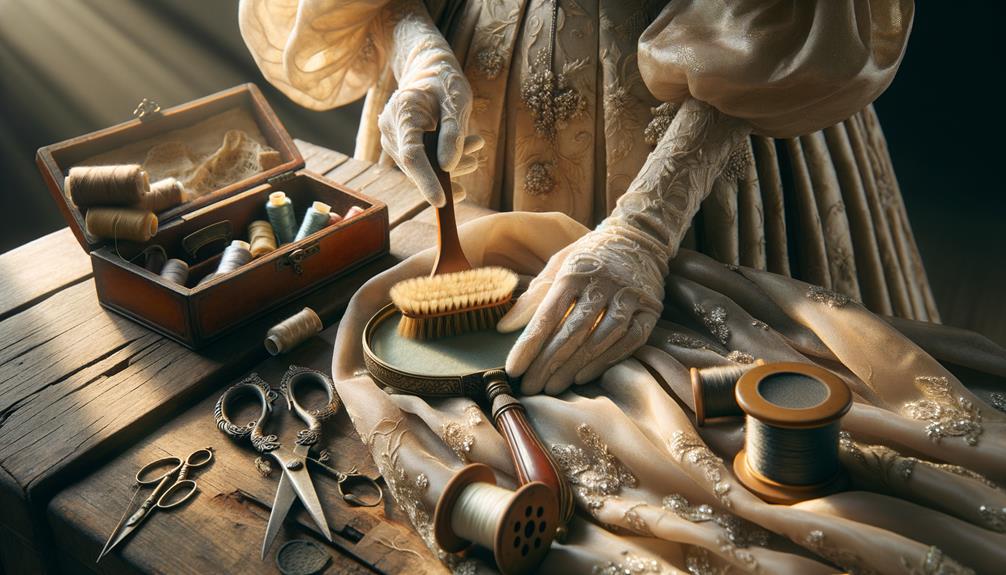
Ensuring the longevity of historical garments requires meticulous attention to cleaning and maintenance practices. When dealing with antique garments, the cleaning process becomes a delicate art. I've found that dry cleaning, though often recommended, isn't always the best approach. Understanding the fabric and its vulnerabilities before proceeding is vital.
Before any cleaning, I carefully examine the garment for signs of weakness or prior damage. This helps me decide whether dry cleaning or a more gentle hand-cleaning method is suitable.
- Assessment: Before cleaning, I carefully examine the garment for signs of weakness or prior damage. This helps me decide whether dry cleaning or a more gentle hand-cleaning method is suitable.
- Testing: I test a small, inconspicuous area of the fabric to ensure the chosen cleaning method won't cause damage. This step is crucial as antique garments can be unpredictable.
- Execution: Depending on the results, I either proceed with a professional dry cleaning service specializing in historical textiles or opt for a meticulous hand-cleaning with gentle, pH-neutral products.
To preserve the delicate beauty of historical fashion pieces for future generations, innovative techniques and an intimate understanding of each garment's history and composition are crucial. By following these steps, we can ensure the longevity of these valuable pieces.
Displaying Antique Garments
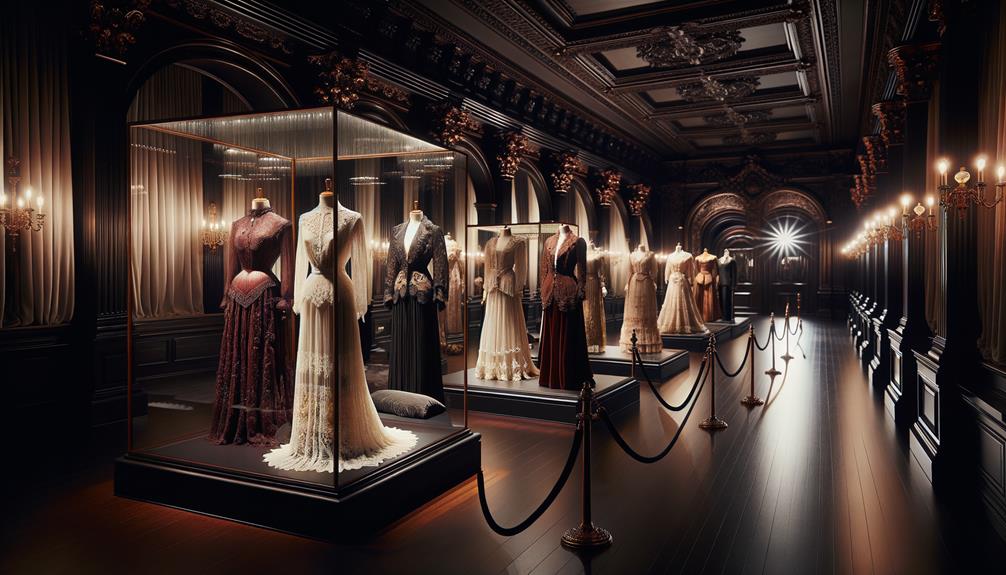
When displaying antique garments, I take extra precautions to ensure their preservation. One crucial step is using UV-protected glass to shield them from the damaging effects of ultraviolet light. This simple step preserves the vibrant colors and delicate fabrics that have withstood the test of time.
In addition to UV-protected glass, I use acid-free materials for both storage and display. This prevents acidic degradation, discoloration, and weakening of the fabric over time.
Displaying an antique garment on a mannequin requires a soft, 100% cotton dress form. This prevents any abrasive damage and supports the garment in a way that mimics its original wear. Direct sunlight can cause significant damage, so I position displays away from windows and areas with fluctuating humidity, like kitchens and bathrooms.
To maintain each piece in pristine condition, I regularly dust them and refold stored items annually, checking for any signs of damage or insect infestation. These meticulous practices allow each garment to be both a visual delight and a preserved piece of history.
Special Care for Accessories
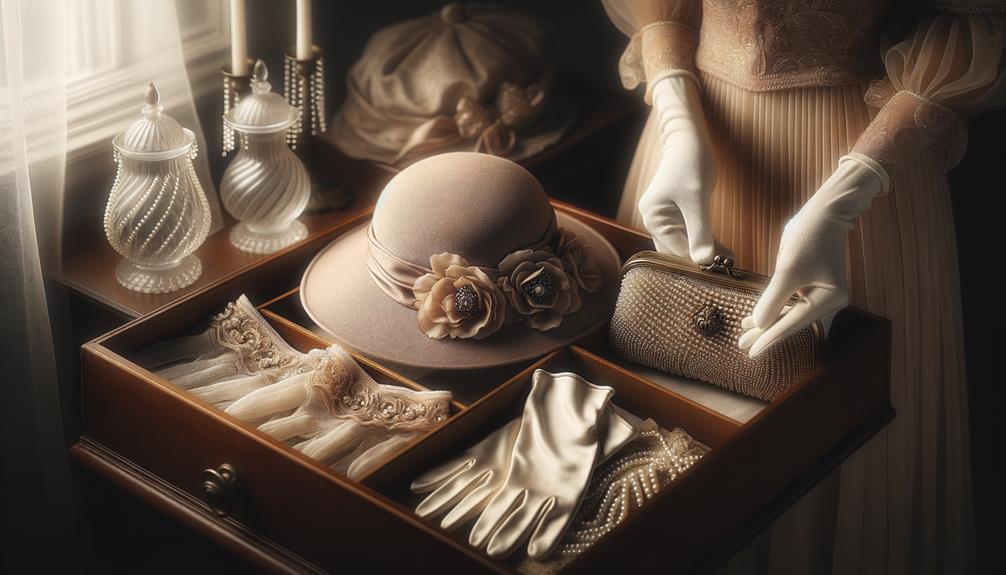
Special Care for Accessories
Just as antique garments require meticulous care, accessories like hats, gloves, and jewelry demand special attention to preserve their delicate beauty and historical significance. I find myself marveling at the thought of Marilyn Monroe's iconic jewelry pieces, each whispering stories of glamour and history. Preserving such treasures isn't just about storage – it's a reverence for the past.
To safeguard these fragile items, I follow these essential steps:
- Individual Storage: Each accessory gets its own compartment or small box lined with acid-free tissue paper. This prevents scratching and tangling, vital for maintaining their pristine condition.
- Archival Materials: Delicate or beaded items deserve museum-quality boxes or velvet-lined cases. The Costume Society of America emphasizes the importance of such materials to prevent damage.
- Environmental Control: Metal accessories like brooches or buckles are stored in cool, dry places, away from direct sunlight and moisture to avoid tarnishing.
For particularly fragile or valuable pieces, I consult professional conservators or textile specialists. Their expertise guarantees that these artifacts – whether they once adorned a Hollywood star or an everyday individual – continue to enchant and inspire for generations to come.
Frequently Asked Questions
How to Preserve Historical Clothing?
I store historical clothing in a controlled environment with minimal light. When handling the items, I wear clean gloves or use clean hands to prevent damage. To prevent folds and creases, I use acid-free materials and add tissue paper padding. For specialized preservation techniques, it's best to consult a conservator.
How to Preserve a 100 Year Old Dress?
When preserving a 100-year-old dress, it's essential to store it in a cool, dry space to prevent damage from moisture and heat. Professional cleaning is a must, as improper cleaning methods can cause irreversible harm. When repairs are necessary, they should be done with care to maintain the dress's integrity. Using acid-free materials is crucial to prevent deterioration. To handle the dress safely, wear cotton gloves to prevent oils from your skin from damaging the fabric. Finally, consult a textile conservator for personalized advice on preserving this valuable piece of history.
How to Preserve Antique Silk?
I store my antique silk in a cool, dry place, away from direct sunlight. To prevent damage, I use acid-free paper and avoid folding. If I'm unsure about the best preservation methods, I consult a conservator to ensure I'm taking the right steps to protect these delicate pieces.
How Long Can Cloth Be Preserved?
How long can cloth be preserved? A thousand years, if you store it perfectly – in a cool, dry, dark place. Even with ideal conditions, technology can only do so much to extend its lifespan.



